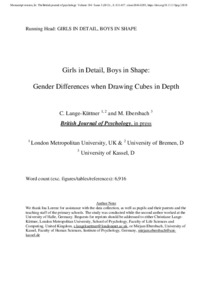Datum
2013Schlagwort
150 Psychologie RaumvorstellungKognitive EntwicklungGeschlechtsunterschiedSozialisationFormenzeichnenExperimentelle PsychologieMetadata
Zur Langanzeige
Aufsatz

Girls in detail, boys in shape: Gender differences when drawing cubes in depth
Zusammenfassung
The current study tested gender differences in the developmental transition from drawing cubes in two‐ versus three dimensions (3D), and investigated the underlying spatial abilities. Six‐ to nine‐year‐old children (N = 97) drew two occluding model cubes and solved several other spatial tasks. Girls more often unfolded the various sides of the cubes into a layout, also called diagrammatic cube drawing (object design detail). In girls, the best predictor for drawing the cubes was Mental Rotation Test (MRT) accuracy. In contrast, boys were more likely to preserve the optical appearance of the cube array. Their drawing in 3D was best predicted by MRT reaction time and the Embedded Figures Test (EFT). This confirmed boys' stronger focus on the contours of an object silhouette (object shape). It is discussed whether the two gender‐specific approaches to drawing in three dimensions reflect two sides of the appearance–reality distinction in drawing, that is graphic syntax of object design features versus visual perception of projective space.
Zitierform
In: The British journal of psychology Volume 104 / Issue 3 (2013) , S. 413-437 ; eissn:2044-8295Zusätzliche Informationen
This is the pre-peer reviewed version of the following article: "Girls in detail, boys in shape: Gender differences when drawing cubes in depth", which has been published in final form at https://doi.org/10.1111/bjop.12010. This article may be used for non-commercial purposes in accordance with Wiley Terms and Conditions for Use of Self-Archived Versions.Zitieren
@article{doi:10.17170/kobra-202103253599,
author={Lange‐Küttner, Christiane and Ebersbach, Mirjam},
title={Girls in detail, boys in shape: Gender differences when drawing cubes in depth},
journal={The British journal of psychology},
year={2013}
}
0500 Oax
0501 Text $btxt$2rdacontent
0502 Computermedien $bc$2rdacarrier
1100 2013$n2013
1500 1/eng
2050 ##0##http://hdl.handle.net/123456789/13070
3000 Lange‐Küttner, Christiane
3010 Ebersbach, Mirjam
4000 Girls in detail, boys in shape: Gender differences when drawing cubes in depth / Lange‐Küttner, Christiane
4030
4060 Online-Ressource
4085 ##0##=u http://nbn-resolving.de/http://hdl.handle.net/123456789/13070=x R
4204 \$dAufsatz
4170
5550 {{Raumvorstellung}}
5550 {{Kognitive Entwicklung}}
5550 {{Geschlechtsunterschied}}
5550 {{Sozialisation}}
5550 {{Formenzeichnen}}
5550 {{Experimentelle Psychologie}}
7136 ##0##http://hdl.handle.net/123456789/13070
<resource xsi:schemaLocation="http://datacite.org/schema/kernel-2.2 http://schema.datacite.org/meta/kernel-2.2/metadata.xsd"> 2021-08-03T16:02:32Z 2021-08-03T16:02:32Z 2013 doi:10.17170/kobra-202103253599 http://hdl.handle.net/123456789/13070 This is the pre-peer reviewed version of the following article: "Girls in detail, boys in shape: Gender differences when drawing cubes in depth", which has been published in final form at https://doi.org/10.1111/bjop.12010. This article may be used for non-commercial purposes in accordance with Wiley Terms and Conditions for Use of Self-Archived Versions. eng Urheberrechtlich geschützt https://rightsstatements.org/page/InC/1.0/ three-dimensional cube drawing occlusion gender differences in spatial abilities appearance-reality-distinction 150 Girls in detail, boys in shape: Gender differences when drawing cubes in depth Aufsatz The current study tested gender differences in the developmental transition from drawing cubes in two‐ versus three dimensions (3D), and investigated the underlying spatial abilities. Six‐ to nine‐year‐old children (N = 97) drew two occluding model cubes and solved several other spatial tasks. Girls more often unfolded the various sides of the cubes into a layout, also called diagrammatic cube drawing (object design detail). In girls, the best predictor for drawing the cubes was Mental Rotation Test (MRT) accuracy. In contrast, boys were more likely to preserve the optical appearance of the cube array. Their drawing in 3D was best predicted by MRT reaction time and the Embedded Figures Test (EFT). This confirmed boys' stronger focus on the contours of an object silhouette (object shape). It is discussed whether the two gender‐specific approaches to drawing in three dimensions reflect two sides of the appearance–reality distinction in drawing, that is graphic syntax of object design features versus visual perception of projective space. open access Lange‐Küttner, Christiane Ebersbach, Mirjam doi:10.1111/bjop.12010 Raumvorstellung Kognitive Entwicklung Geschlechtsunterschied Sozialisation Formenzeichnen Experimentelle Psychologie submittedVersion eissn:2044-8295 issn:0007-1269 Issue 3 The British journal of psychology 413-437 Volume 104 false </resource>
Die folgenden Lizenzbestimmungen sind mit dieser Ressource verbunden:
Urheberrechtlich geschützt

